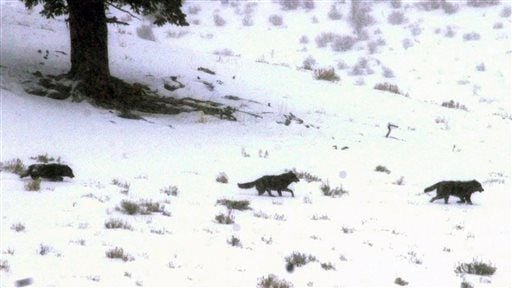Idaho Department of Fish and Game
officials intend to monitor four wolves they improperly radio-collared
in the Frank Church-River of No Return Wilderness during an elk research
project.
“The only way to remove those collars would be to go back in with helicopters,” IDFG spokesman Mike Keckler said Thursday. “And we’re reviewing what happened – taking another look at our procedures to prevent this sort of thing from happening again.”
The four wolves were collared between Jan. 7 and 9 when IDFG used helicopters to capture 30 adult elk cows and 30 calves for a population study in the wilderness area. On Wednesday, Salmon-Challis National Forest Supervisor Chuck Mark issued a notice of noncompliance to IDFG for exceeding the limits of a special use permit to fly helicopters for the elk project.
The notice of noncompliance ordered IDFG to explain how it had decided to collar wolves in violation of the permit conditions and to discuss ways of avoiding future mistakes. It did not ask the state to remove the wolf collars.
A coalition of environmental groups that had sued the U.S. Forest Service in order to block the permit has amended its complaint to address the wolf collaring. Its main argument challenges the Forest Service’s decision to allow helicopter flights for wildlife management in federal wilderness, where agencies are supposed to use the minimal tools necessary to preserve wilderness character.
“The only way to remove those collars would be to go back in with helicopters,” IDFG spokesman Mike Keckler said Thursday. “And we’re reviewing what happened – taking another look at our procedures to prevent this sort of thing from happening again.”
The four wolves were collared between Jan. 7 and 9 when IDFG used helicopters to capture 30 adult elk cows and 30 calves for a population study in the wilderness area. On Wednesday, Salmon-Challis National Forest Supervisor Chuck Mark issued a notice of noncompliance to IDFG for exceeding the limits of a special use permit to fly helicopters for the elk project.
The notice of noncompliance ordered IDFG to explain how it had decided to collar wolves in violation of the permit conditions and to discuss ways of avoiding future mistakes. It did not ask the state to remove the wolf collars.
A coalition of environmental groups that had sued the U.S. Forest Service in order to block the permit has amended its complaint to address the wolf collaring. Its main argument challenges the Forest Service’s decision to allow helicopter flights for wildlife management in federal wilderness, where agencies are supposed to use the minimal tools necessary to preserve wilderness character.
Keckler said two capture teams with helicopters were involved in the elk project. One of the teams did not understand that the Forest Service permit was limited to elk captures only, he said.
“In general when our guys are up in the air, if they encounter a species they want to put a collar on, they do it,” Keckler said. “They saw some wolves and put collars on them. We have apologized for that.”
Idaho currently has 75 wolves with radio collars in its statewide monitoring program, Keckler said. It’s also in the process of collaring more than 400 elk in eight areas of the state. Montana currently has 25 radio-collared wolves.
“The elk population in the Middle Fork between 2002 and 2011 has dropped by 43 percent,” Keckler said. “By placing the collars, it gives us fresh data on the population. If one stops moving because the animal dies, we can go in and retrieve the collar and determine the cause of death. Overall, the elk population in Idaho is rebounding, but in some places it’s not. The wilderness is one of those areas.”
source



No comments:
Post a Comment